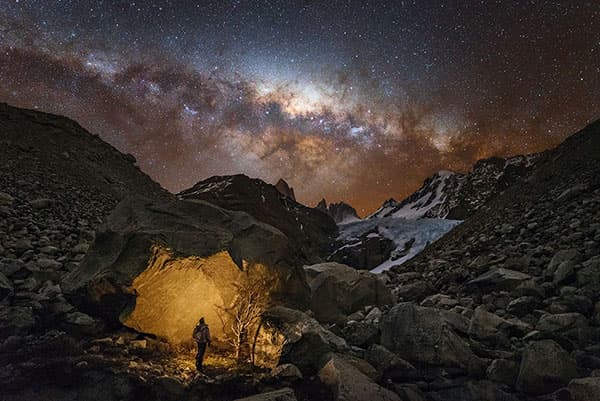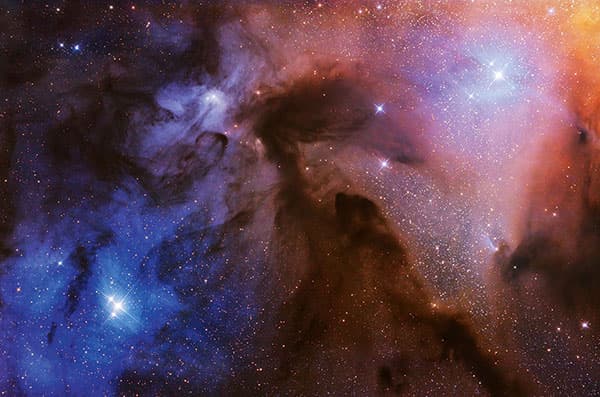
Sky-Watcher 200 mm f/4 reflector telescope, Sky-Watcher HEQ5 Pro mount, Canon 5D Mark II camera, ISO 1600, 15hr total exposure. © Artem Mironov
‘The Rho Ophiuchi Clouds’
by Artem Mironov (Russia)
Insight Astronomy Photographer of the Year Winner, Stars and Nebulae, and overall winner
Taken over three nights at a farm in Namibia near Gamsberg Mountain, this image depicts the Rho Ophiuchi cloud complex. Sometimes known as ‘Rho Oph’ for short or the Ophiuchus molecular cloud, it is named after a bright star in the region. It is a dark emission and reflection nebula about 14 light years across and is situated approximately 460 light years away from our planet, in the constellation of Ophiuchus (the ‘serpent-bearer’). It is one of the closest star-forming regions to the solar system.

Canon EOS 5D Mark III, 24 mm f/2 lens, 6secs, ISO 1600. © Mikkel Beiter
‘Ghost World’
by Mikkel Beiter (Denmark)
Winner, Aurorae
During October 2016 Beiter observed the waves from the sea slowly rolling up on this long beach in Iceland making the sand wet, resulting in great conditions for catching some reflections. Suddenly, clouds emerged from the nearby mountains and floated across the sea allowing him to capture this other-worldly scene of a powerful, teal aurora sweeping across the night sky in Stokksnes, Iceland.
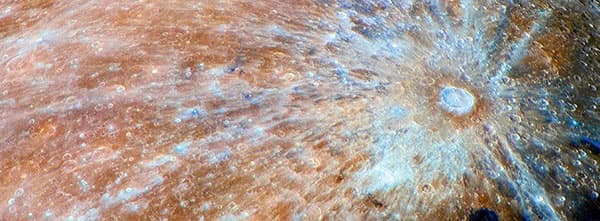
250 mm f/4 reflector telescope at f/10, Sky-Watcher EQ6 mount, ZWO ASI290MM and Sony SLT-A99V, composite of 5,000 monochrome frames and 50 colour frames. © László Francsics
‘Blue Tycho’
by László Francsics (Hungary)
Winner, Our Moon
This hyper-saturated image depicts the face of the lunar surface in a new light. The impact crater and its ray system appear as blue-white structures that extend over a thousand miles. The Tycho Crater, named after Danish astronomer Tycho Brahe, has a bluish shade that is characteristic of the youngest craters on the Moon, with this particular feature estimated to be 108 million years old.
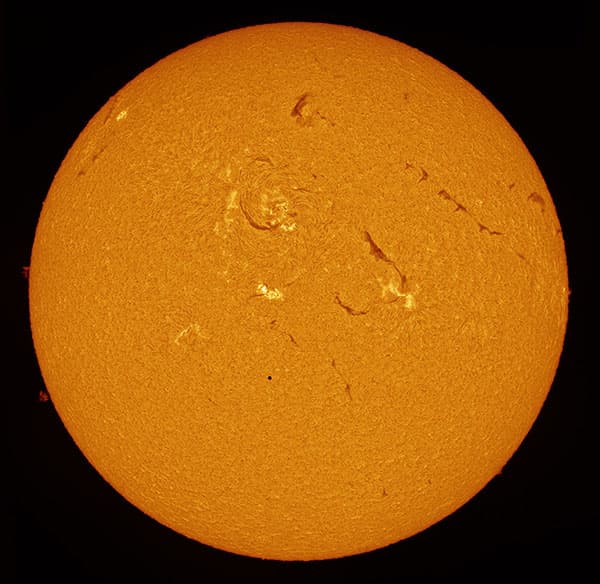
TEC140 140mm f/7 refractor telescope, Solarscope DSF100 H-alpha filter, Sky-Watcher EQ6 Pro mount, PGR Grasshopper 3, stacked from multiple exposures. © Alexandra Hart
‘Mercury Rising’
by Alexandra Hart (UK)
Winner, Our Sun
On 9 May 2016, a transit of Mercury occurred, with the smallest planet in the solar system passing directly between the Earth and the Sun over the course of seven-and-a-half hours. Mercury can be seen towards the centre of the image as a tiny black dot. The day of the transit had dawned cloudy but weather forecasts showed clear skies to the north, and Hart had a kind friend who offered the use of his garden as a viewing area.

QSI 583wsg, 10in f/3.8 homemade reflector telescope at f/4.4, Whiteswan 180 mount, 22hrs. © Oleg Bryzgalov
‘M63: Star Streams and the Sunflower Galaxy’
by Oleg Bryzgalov (Ukraine)
Winner, Galaxies
A bright spiral galaxy, Messier 63 looks like a star necklace in which the stars have crashed outwards from the galaxy’s centre, producing this fantastic long train. The ghostly star arcs of the Sunflower Galaxy had long been an elusive target for photographers, but upon deciding to take the image in one of the darkest places in Europe – the Rozhen Observatory in the Rhodopes Mountains, Bulgaria – Bryzgalov successfully captured such an astronomical object. Despite a warm winter and an early spring, there were snow drifts more than a metre high where he shot this, and it took a lot of effort to break through them.

William Optics 132mm f/5.6 apochromatic refractor telescope, Celestron CGE Pro mount, QSI 660WSG8 Mono CCD, 16 2/3-hour total exposure. © Jason Green
‘The Cone Nebula (NGC 2264)’
by Jason Green (Gibraltar)
Winner, Sir Patrick Moore Prize For Best Newcomer
A vivid deep-red image of the Cone Nebula, lying about 2,700 light years away in the constellation of Monoceros. The image consists of 20 x 10-minute exposures per filter and is an integration of luminance, red, green and blue (LRGB) and hydrogen-alpha (H-Alpha) filters. The image is calibrated with at frames and bias frames, aligned and combined to produce one integrated full-colour image. PixInsight and Photoshop was used to process the image.

iOptron Sky-Tracker mount, Sony Alpha 7S, 18mm f/2.8 lens, 30secs, ISO 5000. © Yuri Zvezdny
‘Wanderer in Patagonia’
by Yuri Zvezdny (Russia)
Winner, People and Space
A lone stargazer stares up at the stars of our galaxy, the Milky Way, as they stretch across the night sky over the Piedras Blancas glacier in the Los Glaciares National Park, Argentina. Alone in the darkness, Zvezdny made his way over the huge rocks with the mountain river roaring under his feet and the glacier rumbling nearby.

Sony Alpha ILCE-7s, 85mm f/1.4 lens, panorama of three 8sec exposures, ISO 10,000. © Haitong Yu
‘Passage to the Milky Way’
by Haitong Yu (China)
Winner, Skyscapes
The serene sight of the dusky Milky Way viewed through the minimalist outdoor passageway of the Large Sky Area Multi-Object Fibre Spectroscopic Telescope (LAMOST) at the National Astronomical Observatory of China. Shot with an 85mm lens, the image is a composite of a three-panel panorama, each one with a single exposure.

Celestron C11 355.6mm f/10 reflector telescope at f/2.7, Sky-Watcher AZ-EQ6 GT mount, ZWO ASI224MC. © Olivia Williamson
‘Saturn’
by Olivia Williamson (UK)
Winner, Young Astronomy Photographer Of The Year
An incredibly detailed image of the ringed planet, Saturn, which 13-year-old Olivia Williamson captured on a trip to the desert near Al Khazna, Abu Dhabi with her dad. The conditions on 27 May meant the body of Saturn appeared to have more detail than she had seen before, resulting in a trip to the desert to escape the light pollution of the city. Using her new ZWO ASI244 colour camera for the first time coupled with excellent conditions, the photographer even managed to capture the beauty of the Cassini Division in the rings.
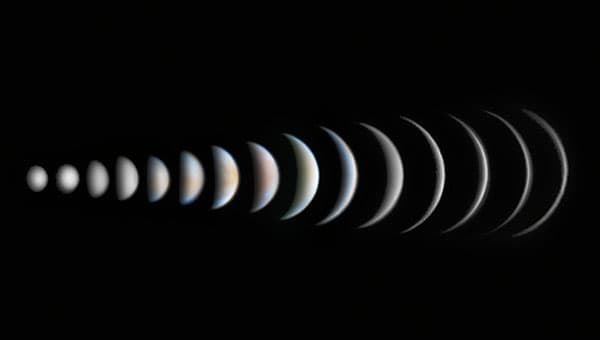
Celestron C11 EdgeHD 355.6mm f/10 reflector telescope, Celestron CGE Pro mount, ZWO ASI174MM. © Roger Hutchinson
‘Venus Phase Evolution’
by Roger Hutchinson (UK)
Winner, Planets, Comets and Asteroids
This image shows the changing face of Venus as it grew from 86.6% illuminated and 11.9in in diameter (as seen from the same spot in London) on 25 September 2016, to 1% illuminated and 59.3in in diameter six months later. Infrared and ultraviolet filters captured cloud features during the larger crescent phases, and those where the apparent diameter is small or the crescent is thin, were taken using only an Infrared pass filter. All were stacked in Autostakkert! and sharpened in RegiStax. Final processing was performed in Photoshop CC.
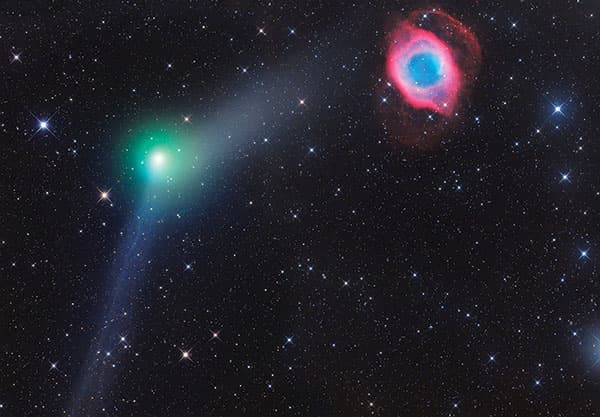
ASA Astrograph 12in N 300mm f/3.6 reflector telescope, ASA DDM 85 mount, FLI Microline ML 16200, 94min. © Gerald Rhemann
‘Encounter of Comet and Planetary Nebula’
by Gerald Rhemann (Austria)
Winner, Robotic Scope
A vibrant image showing the glowing green, comet C/2013 X1 (PanSTARRS) whizzing past the luminous pink-and-blue Helix Nebula, on 5 June 2016. This photograph was taken at an observatory on Tivoli Farm in Namibia, where the photographer installed a mount and telescope with a friend of his. The observatory is fully remote-controlled and frequently maintained during visits, and enabled Rhemann to capture this mosaic image of two panels.
For information about entering next year’s competition visit www.rmg.co.uk/astrophoto.
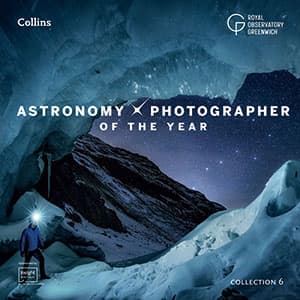
Now in its ninth year, the Insight Astronomy Photographer of the Year competition is run by the Royal Observatory Greenwich in association with Insight Investment and BBC Sky at Night Magazine. The category winning images can be seen at the Royal Observatory’s Astronomy Centre in Greenwich, London until 28 June 2018. Winners and shortlisted entries will also be published in the competition’s official book Astronomy Photographer of the Year Collection 6, ISBN 978-0008-249502, published by Collins in November, priced £25.

